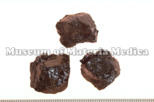Aloe

|
Market name:アロエ Photo location:Museum of Materia Medica, Inst. of Nat. Med., Univ. of Toyama TMPW No.:7516 |
| Synonym | |
| Latin name | Aloe |
| Botanical source: Family name | Liliaceae |
| Botanical source: Plant name | - Aloe ferox Miller (IPNI:529449-1) - Aloe ferox Miller × Aloe africana Miller - Aloe ferox Miller × Aloe spicata Baker |
| Part used | Dried juice of the leaves |
| Empirical criteria for quality selection | Good one is solid and dark brown. The cross- section is smooth and has glassy luster. (TN) |
| Constituents | Polysaccharides: Glycoprotein [Cape Aloes, Socotrine Aloes, Curacao Aloes]: Loctin A Anthraquinones: [Cape Aloes, Socotrine Aloes, Curacao Aloes]: Barbaloin, Aloinoside A, Aloinoside B, Aloe-emodin, Chrysophanol, Aloe-emodin rhamnoside, Rhabarberon; [Curacao Aloes]: Isobarbaloin; [Natal Aloes]: Homonataloin; [Aloe saponaria Haw.]: Aloesaponarin I, Aloesaponarin II, Laccaic acid D methyl ester, Desoxyerythrolaccin Chromones: [Cape Aloes, Socotrine Aloes, Curacao Aloes]: Aloesin, 2''-O-p-Coumaroylaloesin, 2''-O-Feruloylaloesin; Aloesin(Aloeresin B), Aloeresin A, Aloesone(2-Acetonyl-7-hydroxy-5-methylchromone), Aloesol, (2'R)-Aloesol, (2'S)-Aloesol, (2'R)-8-C-Glucosylaloesol, (2'S)-8-C-Glucosylaloesol, (2'R)-8-C-Glucosyl-7-O-metylaloesol, (2'S)-8-C-Glucosyl-7-O-metylaloesol, 7-O-Methylaloesin, Aloesin 2",3",4",6"-tetra-O-acetate α-Pyrones: [A. arborescens Miller var. natalensis Berger]: Aloearbonaside Other aromatic compounds: p-Coumaric acid Naphthalenes: [A. saponaria]: Aloesaponol I, Aloesaponol II |
| Pharmacological effects | Barbaloin: hypercholeresis in small dose, enhanced bowel movement. Barbaloin is C-glycoside of aloe-emodin anthrone. It is metabolized into aloe-emodin anthrone by Eubacterium sp. BAR, enteric bacteria in human intestine. This component stimulates peristalsis and has cathartic effect. |
| Indications | It is widely used for chronic constipation as a laxative. It is applied for apepsia and chronic gastric catarrh as a stomachic in small doses. Since it doesn't contain tannin, it doesn't cause constipation after laxation. In large doses, it congests intestinal wall and pelvic lumen. Therefore, it must be used carefully during menstrual or pregnancy period and hemorrhoid. |
| Diseases | Constipation, Lightheadedness, Red eye, Insomnia, Ear buzzing, Restlessness, Abdominal pain, Malnutrition, Dental caries |
| Formulas | |
| Meridian tropism | Liver, stomach, large intestine |
| Property | Cold |
| Flavor | Bitter |
| Classification in "Shen-non Ben-cao Jing" | |
| TCM: Classification | Purgatives |
| TCM: Medicinal effects | To remove heat from the liver, and to relax the bowels. Used for constipation, infantile malnutrition due to improper feeding and convulsion, external use for eczema and ringworm. |
| Remarks | Listed in the Japanese Pharmacopoeia 18th ed. |
| References | TN: T. Namba & Y. Tsuda ed., Outline of Pharmacognosy, a Textbook, 3rd ed., Nankodo Co., Ltd., Tokyo, 1998. |
